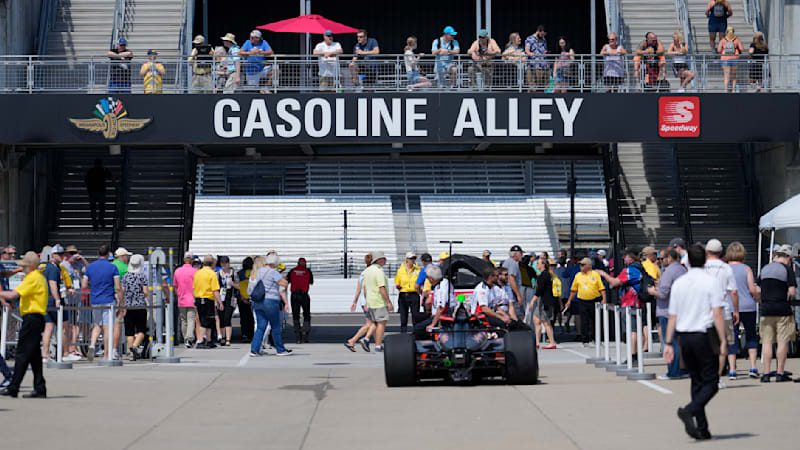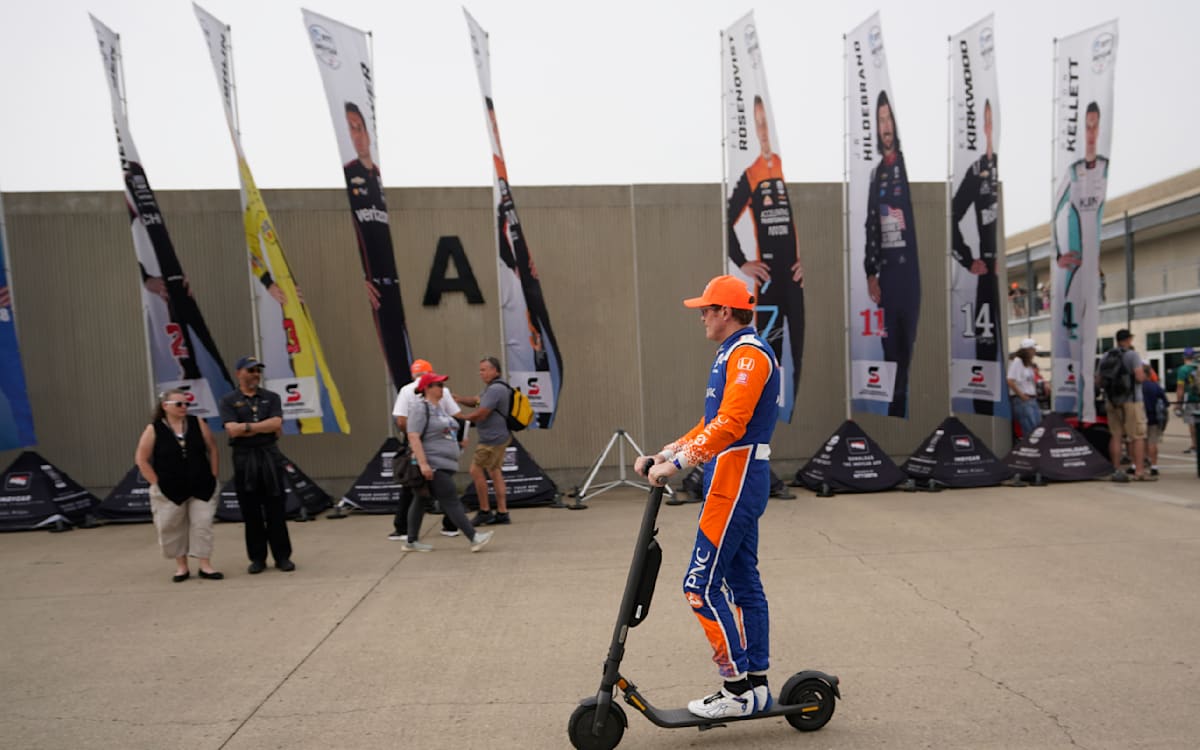Electric Indy 500? 'It’s among the most interesting questions in motorsport'

Will the Indy 500 be electric someday, making Gasoline Alley an anachronistic term like Carb Day? (Associated Press)
INDIANAPOLIS — There’s nothing like the sound of an Indy car speeding down the famed main straight at the Indianapolis Motor Speedway, its engine echoing off the massive grandstands in a way that isn’t heard anywhere else.
There’s a crescendo as the car approaches from the distance of Turn 4, then a burst of peak volume as it passes at nearly 230 mph, and finally a fade into the distance of Turn 1. Anyone who experiences it in person likely never forgets it.
It’s been an aspect of the speedway since Ray Harroun drove the six-cylinder Marmon Wasp to victory in the first Indianapolis 500 in 1911. Cars have evolved and speeds have tripled in the 111 years since, but the constant has been the sweet sound of those internal combustion engines.
But with electric-powered vehicles pushing the auto industry toward a zero-emissions existence, will those loud-and-lovely echoes of Indy eventually fall silent? Is it possible, or even inevitable, that the Indianapolis 500 will be an all-electric race?
“It’s among the most interesting questions in motorsport,” said veteran IndyCar driver J.R. Hildebrand. “Where do we see this going?”
J.R. Hildebrand (Getty Images)
Hybrids on the horizon
Many within the IndyCar paddock believe full electrification of the series is coming. Nobody can predict when, although technology is advancing rapidly. This month at the speedway, there are examples of the speedway and the NTT IndyCar Series emphasizing initiatives to reduce their carbon footprint.
IndyCar will introduce new 2.4-liter twin-turbo hybrid-assisted Honda and Chevrolet engines in 2024 producing 900 horsepower, 100 from the hybrid element. Transporters that carry Indy cars and equipment from race to race are fueled by biodiesel. Electric vehicles have been more prevalent around the speedway this month, from two-wheeled scooters many drivers use to get around to an electric-powered mobile merchandise truck.
“In your mind, you’re going to think,
‘A car going that fast shouldn’t sound like that.’ But it will.”
Firestone, the sole tire supplier to the series, delivered all race tires used at IMS this month via Freightliner eCascadia trucks. Firestone also has developed an eco-friendly alternate tire, constructed with natural rubber from the guayule shrub, that will be used on race cars in the pit-stop contest Friday. The first race on that tire is scheduled for August at Nashville.
That’s a long way from full electrification of race cars, but IndyCar and sports car team owner Mike Shank, whose Meyer Shank Racing car driven by Helio Castroneves won the Indy 500 last year, is preparing for it.
“The way our world is going, it looks like it’s headed that way,” he said. “When we talk about electrification, certainly the hybrid is low-hanging fruit. It’s not just hybrids, but pure electric cars. What we’re trying to do as a team is prepare for that.”
Everyone on Shank’s IndyCar and sports car teams is taking part in a Honda Performance Development training program to learn how to safely work on electric cars.
“Used to be you could take your niece and nephew and shove them in the car for a picture, but (with electric race cars) you can’t do that anymore,” Shank said. “The car’s got to be clear, not powered on, and safe to touch. We worry about safety first, and then how to optimize it later. Technology is moving fast and it’s such an important hot button for all the OEMs, we all know kind of where it’s headed.”

‘Sound is a generational thing’
But how? When? And at what cost to the purists who equate speed with noise and won’t easily accept the relative silence of an electric Indy car?
“Sound is a generational thing,” said Mike Hull, managing director of 14-time IndyCar Series champion and four-time Indy 500-winning team Chip Ganassi Racing. “But the generation that’s going to set the future for the generations that follow (will) have grown up being accustomed to a different sound than we have.”
Hull envisions a person standing near Turn 1 at Indy while an electric race car passes quietly at 230 mph.
“In your mind, you’re going to think, ‘A car going that fast shouldn’t sound like that,’” he said. “But it will.”
“I want to stay current, and I want to do what’s important to the world.”
“Fast and loud” has been the mantra of IndyCar Series president Jay Frye, particularly in development of the new engines in 2024, so it seems clear internal combustion will be around awhile. Hull doubts it’ll be forever, saying auto manufacturers and even governments are defining a future that includes racing.
“The world governments, whatever country you’re in, they’re designing street cars today if you really think about it,” Hull said. “It seems backward to me, but the reality is they are telling the car companies based on the rules and regulations being put in place around the world as to what vehicles need to do for the future. So yes, we will be racing a version of that, there’s no question.”
Shank says the old-school side of him hopes a niche market will remain for gas-powered units.
“But on the other hand, I don’t want to be behind either,” he said. “I want to stay current, and I want to do what’s important to the world.”

Scott Dixon zips through Gasoline Alley on an electric scooter. (AP)
Not an EV kind of race
Hildebrand, who will race in his 12th Indy 500 on Sunday, says the nature of the race isn’t conducive to electric cars in the current form of the technology. The 500 is a max-velocity, accelerator-to-the-floor event from start to finish, with deceleration and braking occurring when drivers pit a half-dozen times for fuel and tires. It’s not nearly enough to regenerate a battery, he said.
“To be able to average 180 miles per hour for 500 miles, we’re a long way from the technology existing to be able to do that,” said Hildebrand, who has been an adjunct lecturer in the vehicular dynamics program at Stanford and is involved with STEM programs when he’s not racing. “Looking at top-tier motorsports, having an electric car compete with an internal combustion engine, the Indy 500 is among the hardest ones to do that.”
“It’s my opinion that the Indianapolis 500 is the place … where in the past these kinds of things were allowed to be explored.”
Still, Hildebrand would love to see someone develop an electric race car and prove it can run laps at Indy as fast as an internal combustion engined car, even if it isn’t ready for a 500-mile race. In a way, it would take Indy back to a time when it was a proving ground for automotive technology. In the current era, IndyCar is a spec-racing series under highly constrained regulations to keep competition balanced and affordable. The racing has never been closer, but experimentation and innovation among teams is extremely limited.
“It’s my opinion that the Indianapolis 500 is the place, particularly in American motorsport and really globally if you look at the historical arc of where motorsport comes from, where in the past these kinds of things were allowed to be explored,” Hildebrand said. “If we followed the same trajectory in the way that regulations are currently written across the sport – we write very highly constrained, highly restrictive rules for a particular type of powertrain architecture – and we’re just waiting for electrification to prove that it can produce 230 mph qualifying laps and an average speed of 175 or 180 mph over the course of an event, it might just never happen. And even if it does, a ton of other stuff will be electric at that point, so it’s not going to be a super interesting thing.”

‘All right, bring it!’
If Hildebrand were in charge, he’d draw up a plan that gives an electric-powered car a chance to at least show how it stands with the internal combustion engine crowd, whether or not it’s ready to race 500 miles.
“I would start today figuring out ways to integrate almost an X-prize style – come and just show me what you’ve got – some kind of mechanism where electrification would be welcome immediately at the speedway in the context of IndyCar racing,” he said. “You can imagine that operating at a qualifying level of pace will come a lot sooner than being able to operate at that speed over the course of 500 miles. If you left it completely wide open to say that anybody who qualifies with any of these technologies gets in the race, that’s a little too open. You could quickly have cars that qualify but have no business competing over the course of 500 miles.”
Hildebrand believes motorsport could be a lot more awesome if it embraces these new technologies over the next decade.
“The point of going racing is to showcase different ways of doing things.”
“Because of its history and because it is one of the hardest places for anything but an internal combustion engine to be any good, Indy is kind of like the perfect place to say, ‘All right, bring it!’ There’s no risk in that,” he said. “There’s a possibility that by doing that, it becomes the place that everybody goes to see this happen. You think about how crazy it was for a turbine car to show up in 1967, imagine how completely insane people would go if you legitimately had electric cars qualifying at the same time as internal combustion engine cars, and there’s this crazy prize. Think about the degree of unpredictability to that relative to what we deal with now. The enormity of that circumstance cannot be overstated.”
And when battery life/regeneration is not an issue in a race like the Indy 500, he would love a scenario where an electric cars battle to the finish with an internal combustion-powered cars.
“Say we get to the end of the race and everybody is on the same strategy, making the same fuel economy,” he said. “You might end up with situations where because of the way electrification works and how much less power density they are giving up under caution relative to an internal combustion engine sitting out there burning (fuel), suddenly the electric cars are the ones with an advantage in the final stint, and you’ve got a runaway of electric cars.
“There’s going to be people who hate that. But that’s kind of the point. The point of going racing is to showcase different ways of doing things and that some things are better than others in certain conditions. That’s why we show up to compete.”



